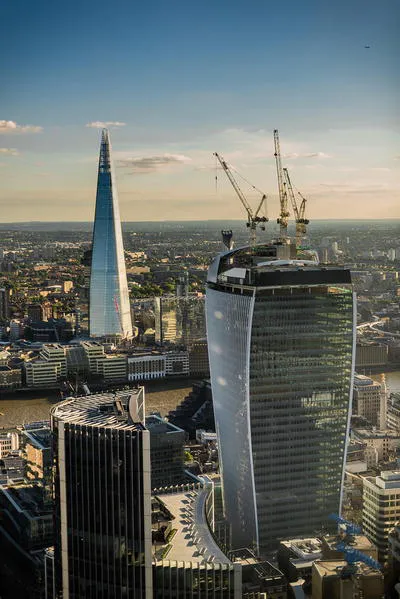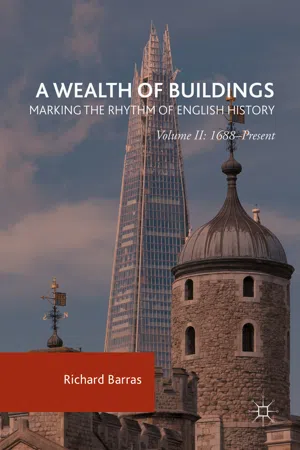Closing the Circle
Completed in November 2012, the 1017-feet-high (310 metres) London Bridge Tower, known colloquially as ‘The Shard’, is the tallest of London’s burgeoning population of office towers. For six brief months, it could claim to be the tallest building in Europe, until surpassed by the 1112-feet (339 metres) Mercury City Tower in Moscow. It is situated at the southern end of London Bridge, almost directly opposite the White Tower built by William the Conqueror nearly a 1000 years earlier. Our progress through the Buildings of England has come full circle.
The Shard stands within the borough of Southwark, the commercial settlement on the South Bank of the Thames that was developed by the Romans as an adjunct to their city of Londinium across the river. Lying outside the effective jurisdiction of the City of London, Southwark acted as its pleasure ground during medieval and Tudor times, famed for its inns, brothels, bear pits, and theatres (Porter 1994: 56). But though not located administratively within the City, it has always functioned as part of the City economy, and never more so than today. Understood not as a place but as a network of financial institutions, the City now exerts extraordinary power not only over the metropolitan and national economies but also over the global economy. For the City is the Olympian home of the deities of finance.
To understand how the City has achieved such an exalted status, we must turn to its historical development as ‘a city within a city’. As late as the Tudor period, the full range of urban activities—residential, commercial, and industrial—was still concentrated within the Roman walls of the City. In other words, the City and City of London were still synonymous. However, the first waves of suburban expansion were already rolling out beyond the City boundaries, a process which gathered pace during the seventeenth century. As the combination of trade, empire, and industry propelled Britain to the forefront of world economies during the eighteenth and nineteenth centuries, so London rose to the forefront of world cities, and the City became the commercial and financial hub of the global economy. During the twentieth century, it has further evolved to become a crucial node in the global network of international finance, a ‘City of capital’ rather than a ‘capital city’ (Coakley and Harris 1983).
The Shard is a child of the globalized economy. It was designed by an Italian architect and engineer, Renzo Piano, financed by a consortium of Qatari investors, and built by a global construction company, Mace Group, at a cost of around £450 million. Orchestrating the whole project has been Irvine Sellar, a multi-millionaire British property developer who, in the great tradition of self-made developers, started life as a market trader.
Qatari involvement in the Shard is symptomatic of a much wider investment drive which has acquired for the fabulously wealthy oil kingdom the ownership of other totemic London landmarks such as Harrods, Claridge’s, and Canary Wharf. Such is the power of international capital in the post-colonial world that this tiny country of less than 300,000 citizens, once a British protectorate, is now able to buy up large quantities of prime real estate in the capital of its former overlord. Members of the Qatari ruling family are also acquiring luxury homes in London, joining others of the global super-rich from Russia, India, and elsewhere who are displacing British nationals from the top tier of the country’s wealthiest residents. Unlike the Normans, these new invaders need no London garrison to safeguard their presence.
Functionally, the Shard is planned as a ‘vertical city’ containing a mix of uses—offices, apartments, restaurants, and a hotel—linked together by 44 lifts. The hotel is franchised to the Chinese leisure group Shangri-La, while among its office tenants is the Qatari media group Al Jazeera (Powell 2015). In its design, the tower is unashamedly Modernist, disavowing the Post-Modernist pastiche developed by architects keen to make modern architecture more acceptable to their clients. The design reflects Piano’s training in the Italian tradition of architectural technology, which aims to display rather than conceal the structure of a building.
The steel, concrete, and glass structure takes the form of a pyramidal tower 73 floors high, topped with a jagged spire rising through a further 23 storeys. According to the architect, the chosen form was inspired by the masts of the sailing ships which once plied the Thames, and by the paintings of Canaletto which feature London’s eighteenth-century skyline of church spires. The energy-efficient triple-glazed units which clad the steel and concrete skeleton are angled so that the appearance of the building changes according to the weather and the seasons, much as different generations of artists have tried to capture the changing light along the river (Piano 2013).
From the outset, the Shard was a project that attracted much controversy. English Heritage, guardian of the nation’s historic buildings, argued that a structure of this scale would visually overpower both the Tower and St Paul’s. It has become an article of popular mythology that the organization unwittingly gave the building its accepted name, calling it ‘a shard of glass through the heart of historic London’. There are many for whom it represents all that is wrong with the new London, global capital of the super-rich where extreme wealth and poverty again coexist in close proximity, as they did in centuries past. This great tower of capital rises blithely oblivious to its immediate surroundings, which are ‘not so much dwarfed as bullied into silence, subject to an act of urban thuggery’ (Hatherley 2012: 346).
Perhaps the greatest aesthetic problem with the rash of skyscrapers which have recently sprung up in and around the City is lack of coherence. Each is a signature statement by one of the world’s leading architects, each identified by a colloquial name designed to capture its unique physical form (Forshaw 2013). Thus the ‘Gherkin’ by Norman Foster (2003) has been followed by Piano’s ‘Shard’ (2012), the ‘Cheesegrater’ by Richard Rogers (2014), and the ‘Walkie-Talkie’ by Rafael Viñoly (2014). These buildings have been superimposed on a medieval street pattern that has survived many centuries of redevelopment. They jostle for space, block each other’s sight-lines, and present a discordant appearance from afar. By contrast, in New York, squadrons of towers rise from a street grid that sets off their differing forms in a powerful sequence of interlocking vistas. The City of London can never be Manhattan; however, much successive Mayors of London may wish it so. Unlike Manhattan, the cityscape of the City will always be less than the sum of its parts; however, many more towers are added to the mix.
The Shard gains in physical presence by standing a little apart from the melee of towers that crowd the City (Photograph
8.1). However, it cannot be detached from the world of finance that inhabits the Square Mile. Piano started his career as a radical, believing that architecture could serve as a progressive force for social change. But as his success grew, so his work has been shaped by the demands of bankers, not the needs of the poor and disadvantaged (Sudjic 2006: 273–8). The Shard may be located in one of the less affluent parts of London, but it functions as part of the very different world across the water.
A World Apart
Since its foundation as capital of the Roman province of Britannia, London has never relinquished its position as the nation’s first city. Within the ever-expanding metropolis, the City has evolved as a world apart, from the rest of the city and the rest of the nation. For almost a millennium, two factors have underpinned its otherness: administrative independence and international outlook. It has developed as a quasi-independent city state, functioning as an integral part of the global economy while still managing to shape the nation’s imperial ambitions and steer its unique course of capitalist development.
What started the City on its separate path was a decision by the Anglo-Saxon king Edward the Confessor, in the middle of the eleventh century, to establish the outpost of Westminster as the seat of national government. The City was granted the right to develop its own autonomous government in the form of a Corporation based on a Lord Mayor, a Court of Aldermen representing local wards, and a Common Council of elected citizens. The City was granted further privileges to raise its own taxes and administer the law to its citizens, which gave it considerable autonomy in its dealings with national government (Barron 2000).
Throughout the reign of successive monarchs, right up to Charles I, there were periodic conflicts between the crown and the City, principally over money. The wealth accumulated in the City through trade and finance was seen by the crown as a valuable source of taxable income and loan capital. The importance of the City to the finances of government has been apparent ever since the Italian banking houses on Lombard Street financed the wars of Edward I, and in return were given privileged access to the funds flowing through the Exchequer. In addition to lending money to the crown, these wealthy merchant bankers controlled much of London’s international trade, exporting wool and textiles and importing wine, silks, and other luxury goods (op. cit. 2000: 401).
There was a symbiotic relationship between the growth of international trade and the accumulation of City wealth. Both accelerated in the sixteenth and seventeenth centuries as global exploration and the first wave of colonization opened up new markets and new trade routes. In the age of mercantilism, the relationship between crown and City became more contradictory. Market regulation to encourage trade and restrict foreign competition not only benefitted the merchant interest but also boosted government revenues through increased customs and excise duties. Yet the City was hostile to the rise of an absolutist monarchy which could threaten its ancient rights and privileges, and so powerful sections within the merchant community joined the citizens of London on the side of Parliament during the English Revolution (Brenner 2003).
We have seen that, following the revolutionary settlement, the City oversaw the development of Britain’s expansionary form of commercial capitalism. During the long ei...


